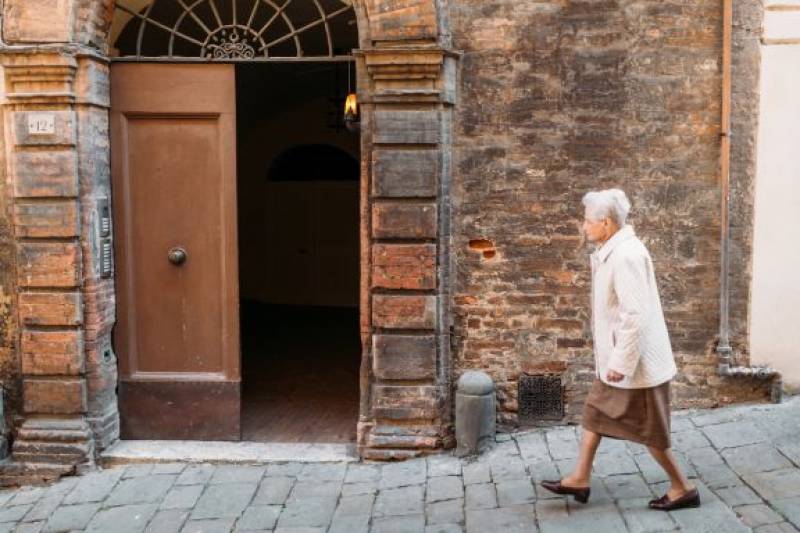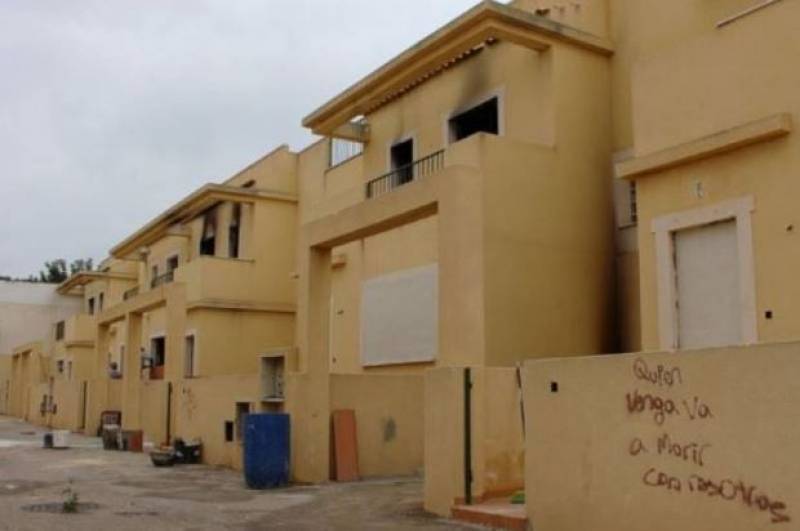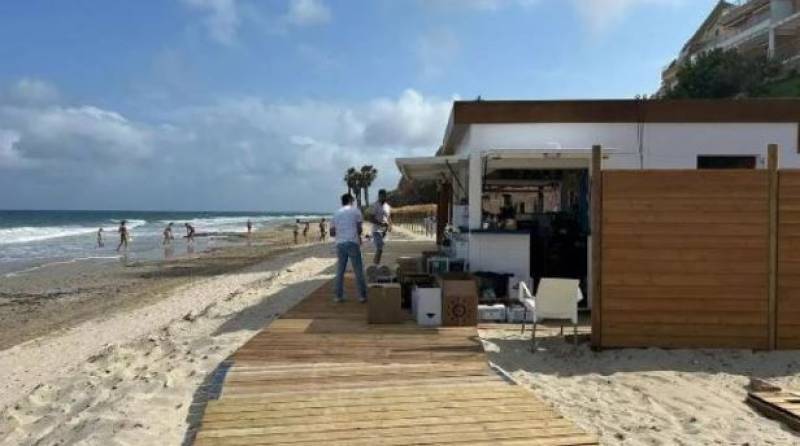- Region
- Águilas
- Alhama de Murcia
- Jumilla
- Lorca
- Los Alcázares
- Mazarrón
- San Javier
-
ALL AREAS & TOWNS
- AREAS
- SOUTH WEST
- MAR MENOR
- MURCIA CITY & CENTRAL
- NORTH & NORTH WEST
- TOWNS
- Abanilla
- Abarán
- Aguilas
- Alamillo
- Alcantarilla
- Aledo
- Alhama de Murcia
- Archena
- Balsicas
- Blanca
- Bolnuevo
- Bullas
- Cañadas del Romero
- Cabo de Palos
- Calasparra
- Camping Bolnuevo
- Campo De Ricote
- Camposol
- Canada De La Lena
- Caravaca de la Cruz
- Cartagena
- Cehegin
- Ceuti
- Cieza
- Condado de Alhama
- Corvera
- Costa Cálida
- Cuevas De Almanzora
- Cuevas de Reyllo
- El Carmoli
- El Mojon
- El Molino (Puerto Lumbreras)
- El Pareton / Cantareros
- El Raso
- El Valle Golf Resort
- Fortuna
- Fuente Alamo
- Hacienda del Alamo Golf Resort
- Hacienda Riquelme Golf Resort
- Isla Plana
- Islas Menores & Mar de Cristal
- Jumilla
- La Azohia
- La Charca
- La Manga Club
- La Manga del Mar Menor
- La Pinilla
- La Puebla
- La Torre
- La Torre Golf Resort
- La Unión
- Las Palas
- Las Ramblas
- Las Ramblas Golf
- Las Torres de Cotillas
- Leiva
- Librilla
- Lo Pagan
- Lo Santiago
- Lorca
- Lorquí
- Los Alcázares
- Los Balcones
- Los Belones
- Los Canovas
- Los Nietos
- Los Perez (Tallante)
- Los Urrutias
- Los Ventorrillos
- Mar De Cristal
- Mar Menor
- Mar Menor Golf Resort
- Mazarrón
- Mazarrón Country Club
- Molina de Segura
- Moratalla
- Mula
- Murcia City
- Murcia Property
- Pareton
- Peraleja Golf Resort
- Perin
- Pilar de la Horadada
- Pinar de Campoverde
- Pinoso
- Playa Honda
- Playa Honda / Playa Paraíso
- Pliego
- Portmán
- Pozo Estrecho
- Puerto de Mazarrón
- Puerto Lumbreras
- Puntas De Calnegre
- Region of Murcia
- Ricote
- Roda Golf Resort
- Roldan
- Roldan and Lo Ferro
- San Javier
- San Pedro del Pinatar
- Santiago de la Ribera
- Sierra Espuña
- Sucina
- Tallante
- Terrazas de la Torre Golf Resort
- Torre Pacheco
- Totana
- What's On Weekly Bulletin
- Yecla


- EDITIONS:
 Spanish News Today
Spanish News Today
 Alicante Today
Alicante Today
 Andalucia Today
Andalucia Today
article_detail
Spanish News Today Editors Roundup Weekly Bulletin Mar 21

TOP STORIES: "Pensioners in Spain will face 3 major changes in April" & "New squatting law in Spain aims to speed up evictions to 48 hours"
Raindrops keep falling on our heads, and they’re forecast to do so until well into next week, too. There’s no let-up to the rain, but even so airports are looking ahead to the summer season already this week, which believe it or not is due to start from the end of this month.
Meanwhile, Spain’s politicians and judges are passing new laws and sentences that get tough on okupas – squatters – and there are changes in store for anyone who receives a Spanish state pension. Let’s begin…
Life of leisure

Next month is set to bring some big changes for retirees in Spain as a series of new measures come into effect on April 1, 2025. Announced last December, these updates are designed to make it easier for older people to keep working while receiving their Spanish pensions, provide more options for those in high-risk jobs and improve access to mutual insurance funds for worker health benefits.
One of the most significant changes is greater flexibility for those choosing active retirement, which allows pensioners to continue working while drawing a portion of their pension.
From April, retirees who have worked for at least 15 years in Spain will no longer have to make full social security contributions to qualify for early retirement. Over time, the amount of pension they can receive while working will also increase, starting at 45% after two years, rising to 55% and eventually reaching 100% after five years.
This is a great new option for people who aren’t ready to fully retire and still want to keep a toe in the water.
Partial retirement, which is slightly different, is also getting a revamp. Currently, pensioners can work part-time while receiving a reduced pension, but the new rules will allow them to retire up to three years early if they have a replacement contract in place. Those retiring more than two years early can initially reduce their working hours by 20-33%.
Additionally, fixed-term workers will now be able to act as substitutes for those taking partial retirement. For retirees who have already reached the standard retirement age, the flexibility increases further, as they’ll now be able to reduce their working hours by up to 75% (instead of the previous 50%) without needing a replacement worker.
For those willing to delay their retirement, there’s even better news. From April, pensioners will receive extra pension payments for every additional six months they work instead of having to wait a full year. This means anyone choosing to extend their time in the workforce will see financial benefits more quickly.
According to the Spanish government, these updates are designed to give retirees more freedom in managing their pensions while encouraging those who want to stay in the workforce for longer to do so with greater flexibility.
Squat a wonderful world

Squatting has become a major issue in Spain in recent years, with thousands of properties illegally occupied and homeowners left in limbo. In 2024 alone, more than 16,000 cases of breaking and entering were reported, highlighting the growing tension between the constitutional right to housing and the protection of private property.
For many homeowners, dealing with squatters has been a frustrating and drawn-out process, often taking years of legal battles before reclaiming their homes. But change is finally on the horizon.
In a landmark ruling, the Barcelona Court of Appeals has decided that property owners can legally cut off gas, electricity and water to squatters who have taken over their homes without permission.
Until now, doing so could land the homeowner in legal trouble, facing coercion charges. While this ruling currently only applies in Barcelona, it’s seen as a potential turning point that could influence legal decisions across Spain.
But there’s even bigger news that will impact the rest of the country. On March 18, the Spanish Congress took a major step toward passing a new law that could dramatically speed up the eviction process. If approved, the legislation would allow property owners to reclaim their homes within just 48 hours of reporting a squatter – provided they can prove forced entry, such as broken doors or windows.
This means cases backed by security footage or witness statements could bypass the lengthy legal procedures that currently allow squatters to hold onto properties for months or even years without paying a cent.
Importantly, the law also aims to close a loophole often used to delay evictions. Under the new proposal, even if squatters claim to be in a vulnerable situation, eviction would not be postponed. Instead, the authorities – not homeowners – would be responsible for finding alternative housing for those in need.
However, the proposed law doesn’t cover all cases of unlawful occupation. Renters who stop paying but remain in a property under an existing lease, known as ‘inquiokupación’ in Spanish, would not fall under this legislation. For homeowners struggling with tenants who refuse to leave, the legal process unfortunately remains as complex as ever.
The proposal has cleared the Lower House of Congress and is now moving up the legislative chain. If fully approved, it would mark a major shift in Spain’s approach to squatting, offering homeowners a faster and more effective way to reclaim their properties. While it won’t solve every issue, it’s a significant step toward protecting property rights and restoring balance to a long-standing problem.
Cor, verano!
 So we’re approaching the end of March, and that means the beginning of the summer flight schedule at Spain’s airports, when there are more flight destinations on offer, and more planes flying each week.
So we’re approaching the end of March, and that means the beginning of the summer flight schedule at Spain’s airports, when there are more flight destinations on offer, and more planes flying each week.At Murcia’s Corvera Airport, the summer 2025 season starts from March 30, when passengers will be able to choose from 18 regular flight routes — 13 international and five domestic — which is double what the winter has had to offer, but is actually a step down from last summer’s menu of destinations.
All the same, there’s a 5% increase in the number of seats on these flights, and that’s partly because Ryanair, for instance, isn’t throwing new destinations into the mix but is upping its weekly flights on existing routes.
So who’s staying and who’s going? Well, flights to Ostrava in the Czech Republic will be no more, while the Moroccan destinations of Casablanca and Marrakesh have both been axed from the lineup this year, though Oujda remains.
Volotea’s Madrid connection, which was around for a grand total of just over a year, has now been discontinued, while the flights to Barcelona limp on until the end of May, after which time they may or may not continue. There’s also talk of a new direct route to Marseille, which would be Murcia’s first direct connection to France, but as yet there are no concrete plans. Meanwhile, the flights to Santander and Menorca have been quietly dropped from this year’s list.
The UK and Ireland are back in full force, though, with flights aplenty to Manchester, Birmingham, Bournemouth, Glasgow, Dublin and London airports. The doubling down on British destinations once again underscores just how important this market sector is for the Murcia tourism industry, while Belgium gets two air connections – Antwerp and Bruges.
Despite trimming down some routes, the airport’s passenger numbers are still expected to grow, and tourism bosses are betting big. Remember that the regional government is throwing over €4 million at tourism promotion in hopes of breaking more records this summer and part of this involves encouraging airlines to bid on new international routes – especially those ever-popular UK ones.
So, if you’ve got a burning desire to see Murcia connected to your local airport, now might be the time to drop Ryanair or easyJet a little hint. They might even listen, though it probably wouldn’t be worth holding your breath until they do.
You can see the full list of Murcia summer flights here, and remember that as the summer season goes on this could change, with new routes being added or taken away, so do keep an eye on it.
Murcia
There was a festivo in Murcia this week, and in Alicante too, on Wednesday March 19, which also happened to be the Spanish version of Father’s Day, el Día del Padre. That’s because March 19 is the Catholic Feast of San José, or Saint Joseph – the father of Jesus Christ.
There was a time when this date was a festivo nationwide, but not anymore and now it’s been left to each autonomous community to decide whether they want to keep this one or not; only Murcia and the Valencian Community did, and it’s in this later place where the date coincides with the end of the famous Fallas festival.
In Murcia and Alicante, then, many shops were shut except for a couple of supermarket chains like Lidl, although in the Port of Mazarrón there was a very festive atmosphere thanks to a parachute aerobatics display, which the sun was nice enough to pop its head out for.
But while Wednesday and Thursday were nice enough, in general it’s been another week of rain in Murcia that once again left flooding in some areas thanks this time to Storm Laurence. Águilas and Mazarrón were hit particularly hard on Tuesday, with roads turning into rivers and emergency services receiving endless calls. In Águilas alone, more than 65 weather-related incidents were reported.
At one point, nine people had to be rescued from their vehicles after getting trapped on the waterlogged RM-D18 road, while school was cancelled once again in 15 different municipalities across the south as the rain made any sort of normal functioning impossible.
And as if flooding wasn’t enough, a tragic discovery added a sombre note to the chaos. A body was found in the Segura river of a man who had gone missing eight days earlier during Storm Jana.
Emergency crews had been searching tirelessly, drones buzzing overhead, police scouring riverbanks, and the water flow even lowered to help the effort. Sadly, all they found was confirmation of what many had feared. The man’s identity has been confirmed as that of an African migrant worker in the agricultural sector who was resident in Spain and who had been swept away by the flood waters.
 On the A7 motorway near Murcia, a coach packed with pensioners on one of those Imserso package tours overturned. Forty passengers were on board and had to be rescued by firefighters to huddle on the hard shoulder with umbrellas. There were at least 16 people injured – some of them requiring hospitalisation – but, remarkably, no fatalities.
On the A7 motorway near Murcia, a coach packed with pensioners on one of those Imserso package tours overturned. Forty passengers were on board and had to be rescued by firefighters to huddle on the hard shoulder with umbrellas. There were at least 16 people injured – some of them requiring hospitalisation – but, remarkably, no fatalities.Other motorists jumped in to help, smashing windows and pulling elderly passengers to safety, and firefighters had to cut at least one person free, all while traffic backed up for kilometres. It was the driver came off worst, with serious injuries to his arm. It’s not been confirmed that it was the heavy rain that led to the accident, but all signs point that way.
Still, there’s been a rare bit of good news from the Mar Menor this week. Illegal irrigation of farmland surrounding the famous lagoon has reportedly been largely stamped out. After years of ignoring rules and watering land they weren’t supposed to, leading to run-off of pesticides and chemicals into the Mar Menor’s ecosystem, farmers are finally toeing the line, or so the authorities claim, saying that illegal irrigation on nearly 9,200 hectares of land has been brought under control.
In addition, around 57% of the land has already been returned to its natural state. Not only that, but local farmers are apparently on board with the crackdown, proof that miracles do happen. The regional government has pledged to throw €273 million at the problem between now and 2040, with an extra €30 million from the central government to help secure the lagoon’s future. Whether that’s enough to clean up years of environmental misbehaviour remains to be seen, but at least the effort seems genuine for once.
The news from the Ayuntamiento de Murcia is not so positive, at least not for homeowners in the municipality. If you own property in the capital city or in areas like the golf resorts of El Valle, Corvera and Hacienda Riquelme, prepare to dig a little deeper as the annual IBI property tax is going up by 3.4%. With this increase, Murcia council forecasts receiving a lovely €10 million more in revenue than last year, and the taxes are set to increase incrementally each successive year until 2028. Let’s hope they put the money towards some socially useful projects for the locality instead of just reorganising the direction of traffic in the city centre once again!
 At least there’s a chance to look up (literally!) as Los Alcázares is getting ready to host a seaplane airshow in early May. Probably buoyed and a little jealous of the success of San Javier’s air show last year, they are hosting their own this year.
At least there’s a chance to look up (literally!) as Los Alcázares is getting ready to host a seaplane airshow in early May. Probably buoyed and a little jealous of the success of San Javier’s air show last year, they are hosting their own this year.Actually, Los Alcázares’s aviation heritage goes way back to 1921, when it became Spain’s first military seaplane base, and now they’re turning that piece of history into a two-day festival, part of the larger “SPLASH-IN” event that starts in Mallorca and finishes in Los Alcázares. There will be big, shiny aircraft from Spain, Switzerland, Italy and Germany showing off their moves, plus competitions, displays and a whole lot of aviation history. Should be fun.
Until then, though, this weekend is forecast to be another drizzly one but, weather permitting, there will be some events taking place around Murcia. Sticking in Los Alcázares, the main carnival parade is scheduled for this Saturday March 22, assuming it doesn’t pour down, and this weekend also sees the start of a salted seafood festival in Águilas – very niche but probably going to be a lot of fun. You’ve also got a tapas route going on in Fortuna, a flea market taking place on the La Manga strip on Saturday morning, a charity concert in Caravaca on Saturday evening to raise money for those affected by last October’s DANA in Valencia and on Sunday a bikers’ day out in the Alhama village of El Berro. Plenty to choose from!
For more events and activities coming up soon in the Region of Murcia see our EVENTS DIARY:
Spain
Anyone else completely and utterly sick of the rain? Yes, Spain has been in drought conditions for years and it’s true that most of the country desperately needs the rain to top up the reservoirs, but I think we’re still allowed to feel slightly disgruntled about the damp and dreary weather that seems never-ending.
March has been an absolute washout across the country and if the forecasts are anything to go by, we’re not quite out of the woods yet. But with the month already halfway over, a lot of us are probably wondering what spring has in store.
Well, according to the experts, we’d better start dusting off the fans and air con remotes because it looks like we’re in for a scorcher.

Why is she reading a blank page?
Spain’s State Meteorological Agency (Aemet) has just released its forecast for April, May and June, basically covering what we can expect for the entirety of astronomical spring, which officially began on March 20 at 10.01am.
While long-range predictions aren’t set in stone, meteorologists are saying there’s a 70% chance that this spring will be even hotter than last year.
But this isn’t really anything unusual. Spring in Spain is now just a new offshoot of summer: the last cold snap we had was way back in 2018.
What’s still a bit of a mystery is the rain. March has come in strong with plenty of downpours, but whether we’ll see more or less rain in the coming months is anyone’s guess.
“To be honest, we don’t know what will happen with the rainfall; the different models can’t agree,” Aemet spokesperson Ruben del Campo said last week.
What we do know is that all this recent rain has officially pulled Spain out of two major droughts – the short-term one that lasted a year and the longer, three-year drought that had been causing serious concerns.
Despite all the recent wet weather, winter was actually a lot milder than usual in both mainland Spain and the islands. Every single month recorded above-average temperatures, with thermometers sitting 1.2°C higher than the usual reference period (1991-2020). And while we’ve had a few chilly days here and there, we never actually hit the threshold for a true cold snap.
In fact, out of the last ten winters, only one – 2017-2018 – was actually cold. The rest have been warm or very warm. So if you’re like me, grumbling about the rain right now, it looks like we’ll be back to complaining about the heat soon enough. Typical Spain, right?!
Talking of typical, the introduction of the European Travel Information and Authorisation System (ETIAS) has been pushed back yet again, with the European Union confirming that the scheme won’t be fully mandatory until 2027.
Originally scheduled for launch in 2026, ETIAS is designed to improve border security and streamline entry into the Schengen Area for travellers from non-EU countries, including the UK.
This latest delay gives visitors from outside the EU, including British travellers heading to Spain, a bit more breathing room before they’ll need to apply for authorisation.
Once implemented, ETIAS will require travellers to complete an online form, provide personal details, answer security questions and pay a €7 fee. The authorisation will then be linked to their passport and remain valid for three years or until the passport expires, whichever comes first. Children under 18 and adults over 70 will be exempt from the fee.
One of the key reasons for the delay is the EU’s priority to first launch the Entry/Exit System (EES), which is expected to go live later this year. The EES is a separate initiative that will impact non-EU travellers who don’t require a visa, such as those from the UK and the US, by introducing automated border checks that register entry and exit details electronically.
The EES system must be up and running before ETIAS can be rolled out.
According to EU sources, ETIAS is now expected to be introduced in late 2026, with an exact start date announced closer to the time. For the first six months it will be voluntary, allowing travellers to familiarise themselves with the new process.
However, by mid-2027, it is set to become a requirement for visitors to Spain and other Schengen countries – assuming it has actually come into force by then!
Banking in Spain isn’t always easy – it can be costly, complicated and even downright frustrating at times. That’s why more and more people are turning to online financial platforms for lower fees, simple international transfers and user-friendly apps. But one major hurdle has kept digital banks from fully competing with traditional ones: the inability to pay taxes through many online accounts.
 Revolut is aiming to change that. By the end of 2025, the banking giant expects to hit 6 million customers in Spain, solidifying its position as a major player in the country’s banking scene. To make that happen, it has taken a crucial step by partnering with the Spanish Tax Agency (AEAT) to allow users to pay their taxes directly through the Revolut app.
Revolut is aiming to change that. By the end of 2025, the banking giant expects to hit 6 million customers in Spain, solidifying its position as a major player in the country’s banking scene. To make that happen, it has taken a crucial step by partnering with the Spanish Tax Agency (AEAT) to allow users to pay their taxes directly through the Revolut app.With this new option, Revolut customers will be able to handle personal income tax (IRPF), VAT self-assessments and corporate tax payments, either via card or direct debit. However, for now, this feature is only available to Business Pro users, with no word yet on when basic account holders will gain access.
Once this change is implemented, the next step is to establish a partnership with Social Security so that users can receive benefits such as unemployment or retirement payments in their Revolut account.
Revolut is also finalising the details of a pilot program to launch a nationwide ATM network. The plan is to start in large cities like Madrid and Barcelona, then expand to other major cities and big towns. Once the ATMs are up and running, customers will of course be able to withdraw cash, but also enjoy some other handy functions like opening a bank account using a QR code.
Alicante
Five days ago, Orihuela Costa hosted one of the biggest and brightest parties of the year for St Patrick’s Day and the parade held on March 16, now one of the largest in Europe, was an overwhelming success.
And talk about the luck of the Irish! After what felt like endless days of rain, the sun finally decided to show up, bathing the festivities in glorious sunshine – just in time for the thousands of revellers who came out to soak up the craic.
 It’s estimated that around 25,000 people of all nationalities flooded to the Cabo Roig strip for the massive parade. More than 40 groups from all over the world joined in, making it a true melting pot of cultures.
It’s estimated that around 25,000 people of all nationalities flooded to the Cabo Roig strip for the massive parade. More than 40 groups from all over the world joined in, making it a true melting pot of cultures.Kicking off at 3pm from Calle Agua, the parade was led by none other than Grand Marshal Charlie Redmond, a Dublin Gaelic football legend and all-round crowd favourite. From there, the streets exploded into a sea of bagpipes, stilt walkers, dancers, and dazzling floats, creating a feast for the senses that had spectators cheering from every corner.
Hats off to the organisers, who absolutely knocked it out of the park. The compliments were flowing as fast as the pints of Guinness and if this year’s parade is anything to go by, we can’t wait for Paddy’s Day 2026!
Meanwhile, some welcome improvements could be coming to the woefully inadequate healthcare services in Orihuela Costa, with plans in the works for a brand-new private hospital and shopping centre. The proposed site sits between Calle Pimienta and Clavo on the Villamartín road, right across from the Los Dolses residential area – just a stone’s throw from Zenia Boulevard commercial centre and 500 metres from the AP-7 motorway.
The project, a collaboration between two companies, consists of a two-storey, 16,000-square-metre building that will combine healthcare and retail spaces. The entire plot measures 33,400 square metres, but much of it will be dedicated to green areas and walkways, so the large development shouldn’t be too much of an eyesore.
Right now, the exact nature of the facility is still up for debate. It could be a medical centre or even a nursing home, but the developers are leaning towards a full-scale hospital. And it’s easy to see why: Orihuela Costa is crying out for better healthcare services.
For the past five years, the council has been promising to either expand the Aguamarina health centre in Cabo Roig or build a new facility somewhere else. So far, nothing has materialised.
That leaves Orihuela Costa’s 30,000 year-round residents dealing with long queues at Aguamarina or having to travel to Torrevieja’s public hospital or the private Quirón Hospital. And in the summer, when the population swells with tourists, the pressure on medical services only gets worse.
Back in January, Orihuela’s mayor, Pepe Vegara, announced that Ribera Salud had been given the green light to build a private hospital in Lomas de Cabo Roig but since then, there’s been radio silence on the project.
Meanwhile, the new Los Dolses development is still in its environmental assessment phase. Although some environmental groups have raised concerns, initial studies suggest the construction won’t have any major negative impact. If all goes to plan, the project will soon move into the next stage.
Unfortunately though, it’s not all good news, as the debacle over Orihuela’s beach bars rumbles on. At the start of January 2023, all of the area’s chiringuitos, along with their toilets, sunbeds, umbrellas and water sports services, were shut down by Orihuela City Council. This was only meant to be a temporary measure until new contracts for the running of the bars were awarded.
 Easter came and went, the summer came and went, but the bars remained closed. Finally, last summer, most of Orihuela Costa’s beach bars were allowed to reopen under new management. All, that is, aside from three of the most popular: Cala Estaca in Playa Flamenca, Punta Prima beach and Cala Mosca, again in Playa Flamenca.
Easter came and went, the summer came and went, but the bars remained closed. Finally, last summer, most of Orihuela Costa’s beach bars were allowed to reopen under new management. All, that is, aside from three of the most popular: Cala Estaca in Playa Flamenca, Punta Prima beach and Cala Mosca, again in Playa Flamenca.To this day, there are no services on any of these beaches and incredibly, the job of running them has been put out to tender yet again. But it’s far too late now for anyone to open them by Easter week so if we’re lucky, the Playa Flamenca and Punta Prima beaches just might have chiringuitos by the time summer rolls around.
And finally, nothing says ‘big day jitters’ quite like getting arrested before even setting foot in Spain. That’s exactly what happened to one Ryanair passenger whose pre-wedding trip to Alicante took a detour straight into the arms of the Guardia Civil after he decided that vaping at 30,000 feet was a good idea.
The groom-to-be, clearly not up to date on the whole ‘no smoking on planes’ rule, was repeatedly warned by the crew after ignoring the ban. But, according to fellow passenger and comedian Katrina Robinson, he just couldn’t resist a few more sneaky puffs of his pineapple-flavoured vape.
“Everything was kicking off,” she reported on TikTok, where footage of the incident has now racked up more than 300,000 views.
“Apparently the man was getting married in Spain, imagine that being the man you’re marrying, how embarrassing, all for a pineapple vape on a two-hour flight,” she added.
To make matters even more cringe-worthy, the vaping culprit tried to charm his way out of trouble by addressing all the flight attendants as ‘Señor’ – a move that only earned him more eye-rolling from fellow Brits on board.
“So embarrassed to be British right now,” Ms Robinson quipped.
Unsurprisingly, when the plane landed in Alicante, several Guardia Civil officers were already waiting on the tarmac to welcome the groom in a way that likely wasn’t part of his wedding itinerary.
Social media, of course, had a field day with the whole thing. One user asked: “Do flights ever land in Alicante without the police having to lift someone?”
Andalucía
For Andalucía, the recent storms have been particularly damaging. Since the start of this string of storms that have hit Spain – from Jana and Konrad to Laurence and now Marthinho – there have been around 3,000 emergency incidents across the region.
Emergency services were kept more than busy, with almost 200 callouts in one day alone this week. Seville, Córdoba and Huelva took the brunt of it, and the stories emerging are heartbreaking and terrifying.
In Seville’s Sanlúcar la Mayor, a 40-strong film crew found themselves suddenly starring in a real-life disaster movie as floodwaters from the Guadiamar River trapped them. Firefighters and police had to get them out via the A-472 highway, while a 73-year-old man in Arahal narrowly avoided becoming flood debris himself, saved by neighbours with a tractor and some quick thinking. Another man was not so lucky, being swept away by the river to his death.
In Córdoba’s Belmez, a man had to be rescued from his own home, surrounded by rising water, while in Añora, authorities launched a search for a missing cyclist in his 70s. Over in Huelva, the storm left people stranded and forced night-time evacuations by boat. Homes near the Odiel River were flooded, and a couple had to be rescued from their car, with the woman ending up in hospital for suspected hypothermia.
Parts of Córdoba saw buildings crumble. In Peñarroya-Pueblonuevo, an abandoned house lost its roof, and in La Palma del Condado, a wall collapsed onto a three-year-old boy. Luckily, his injuries were minor, but the family was evacuated anyway. All in all, Storm Laurence left a trail of soggy destruction this week, and emergency teams are still on high alert as the rain is forecast to continue into next week.
 Over in Marbella, the disappearance of a woman (not related to the rain) has people scratching their heads. Martina Glase, a 61-year-old German woman, has gone missing, along with her dog, Ellie. She was last seen in Elviria, Marbella, on Friday, and her phone mysteriously went dead that afternoon.
Over in Marbella, the disappearance of a woman (not related to the rain) has people scratching their heads. Martina Glase, a 61-year-old German woman, has gone missing, along with her dog, Ellie. She was last seen in Elviria, Marbella, on Friday, and her phone mysteriously went dead that afternoon.She was driving a distinctive blue Daihatsu with German plates, but both she and the car have vanished. The police are urging anyone who’s seen her, her car or even just Ellie to come forward. At this point, any clue could make all the difference.
While some people are vanishing without a trace, others are making spectacular returns. Over in Málaga’s Churriana district, a thief managed to injure a shopkeeper during a robbery… but that wasn’t his most impressive move. No, that came afterwards, when he returned to the crime scene to pick up the wallet he’d dropped, which, of course, contained his ID.
The shopkeeper, still recovering from head and arm injuries, wisely didn’t try to stop him. The police, however, now have the thief’s details and presumably a solid reason to believe that criminals really aren’t always criminal masterminds.
And finally, on a more lighthearted note, a small town in Málaga is about to play a key role in the next big step in e-commerce.
The little village of Villanueva del Trabuco has been chosen by Mastercard to trial its new ‘Click to Pay’ system. Basically, this is a tech fix for all of us who can’t be bothered to type out our names, card numbers and addresses every time we buy something online.
Villanueva del Trabuco has been chosen to join an exclusive club of European towns with long and unpronounceable names, all picked for this pilot scheme. If it works, shoppers everywhere can thank this tongue-twisting little town for making checkout screens a bit less painful!

You may have missed…
- Holiday scam survey in Spain reveals the surprising number of tourists caught out.
Spain has been named the number one destination where tourists are most likely to fall victim to scams, with over one million travellers reporting they’ve been caught out in the last five years. - Measles outbreak hits Spain with cases surging.
For many years now measles has taken something of a backseat to other common illnesses, thanks in large part to the high number of parents who choose to vaccinate their children. But the disease is making an unwelcome comeback in 2025, both in Spain and in the rest of Europe. - Spanish train strikes called off.
Renfe and Adif unions have called off the 7-day strike which was scheduled to begin on Monday March 17, affecting public transport up and down the country including Cercanías, Rodalies AVE, Avlo and Medium and Long Distance trains. Those representing the train drivers reached a last-minute agreement with the Ministry of Transport after just four hours of industrial action. - The body of an elderly woman left in a wheelchair outside Jaén hospital.
Police in Jaén are investigating a bizarre and unsettling incident after a heavily disguised man left the body of an elderly woman in a wheelchair outside a hospital before running away. - UK Embassy warns that green certificate will not be recognised by the EU's Entry Exit System.
The British Embassy in Spain is urging all UK nationals to apply for a TIE following confirmation this week from the Spanish Government that the Green Certificate will not be recognised under the EU’s new Entry/Exit System (EES).
And that’s that for another week. See you next week!
Bye bye!
Contact Murcia Today: Editorial 000 000 000 /
Office 000 000 000
















